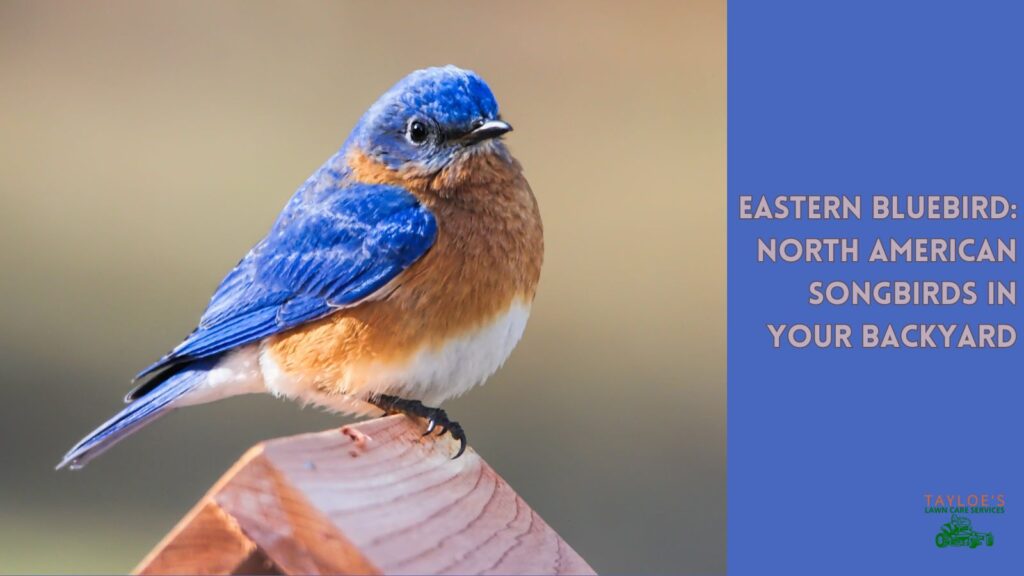Last Updated on: 12th December 2025, 12:44 pm
Songbirds are melodious and a great aesthetic enhancer to any landscaping or backyard. Provided you meet their survival needs, these feathered friends will spare time from their busy schedules to offer you company. Undoubtedly, you’ll find it relaxing to spend your time observing their behaviors.
Furthermore, these birds play a crucial role in your garden’s ecosystem. They serve as pest controllers, from aphids to snails. That’s because birds feed on insects, some of which can destroy your lawn or garden. And so, allow the birds to take charge of your pest control plan, and you won’t have to apply chemical pesticides.
Unexpected Benefits of Encouraging Song Birds to Visit Your Garden
You’ll find other benefits of birdwatching. Not only will these songbirds entertain you, but they are also natural garden helpers.
- Weed control: Finches, sparrows, and most other songbirds eat weed seeds, ridding your garden of unwanted plants, so you don’t have to worry.
- Flower pollination: Sunbirds, orioles, hummingbirds, and the other nectar-sipping birds, are great pollinators of your favorite flowers, facilitating new blooms.
We will warn you that they will demand payment by snacking on some of your berries and fruits. But sharing with them might be worth it.
Attract These Fourteen Song Birds and Enjoy Their Antics
These fourteen songbirds will delight you and provide benefits to your garden.
1 – Chickadees
Other than their sweet melodies, chickadees are pest-control champions. Nearly 90% of their diet comprises flies, moths, bugs, beetles, leafhoppers, plant lice, treehoppers, and scale.
In the winter, they stay on patrol, searching through bark crevices for moth’s eggs, katydids, pear psylla, plant lice, and other hibernating insects.
And so, to keep them (together with their cousins, titmice) on patrol during winter, offer them sunflower seeds in a feeder or suet in some mesh bag—and in the spring, wood chips packed in a nest box.
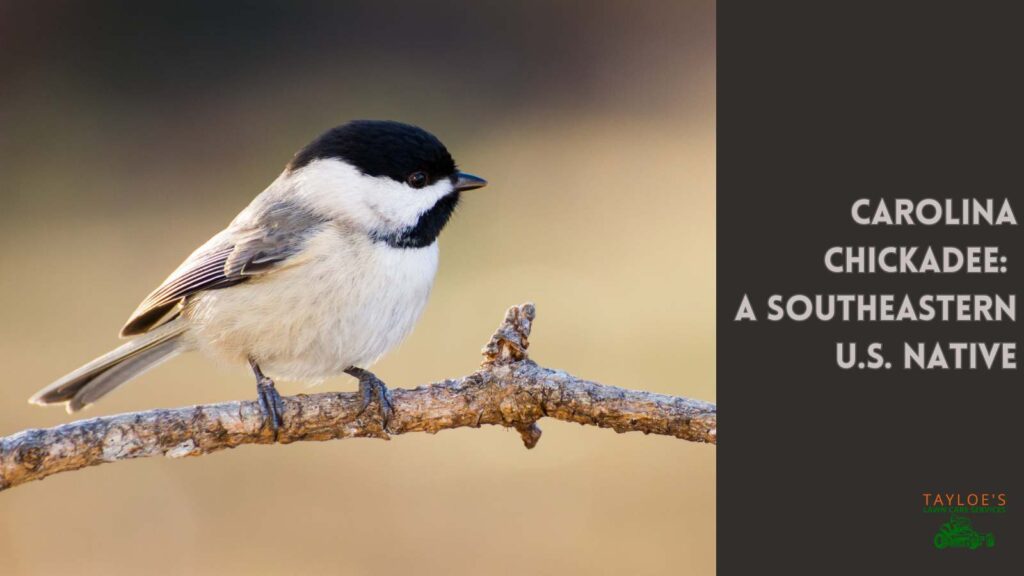
2 – Grosbeaks
These medium-sized bird species are notorious visitors of yards. Therefore, quite easy to attract with a pleasing garden aesthetic, plus the right snacks.
They have quite an expansive diet, making it even easier to catch their attention.
Grosbeaks exhibit cone-shaped beaks—well suited for seed consumption, although berries and insects also make part of their diet.
Offer them adequate cover by planting more shrubs—to encourage them to nest in the perimeters of your yard.
3 – Sparrows
Sparrows feed mainly on seeds, preferring ragweed, crabgrass, and pigweed.
However, during the nesting season, they switch to the protein-rich diet that primarily consists of insects (mostly caterpillars, beetles, grasshoppers, ants, true bugs, and leafhoppers) —to nourish their health as well as that of their young ones.
To lure them into nesting in your yard, offer nesting materials such as string, bark, or straw pieces.
Caution: Sparrows enjoy snacking on youwinter crops—uprooting seedlings and sprouts—so consider using row covers to protect the young seedlings.
4 – House Wrens
They are quite tiny, though among the most widely spread native bird species in the Americas.
With their warm brown color, you’re likely to spot them in thickets near woods, gardens, parks, and yards.
House wrens exhibit varied nesting behaviors, often preferring natural tree cavities, bird boxes, or woodpecker holes.
Leaving brush piles in your yard is a great way to offer these merry songbirds some cover, protection, and food (mostly insects).
5 – Thrushes
Generally, thrushes (including redstarts, bluebirds, American robins, fieldfare, hermit thrush, European robins, and wheatears) are shy bird species—you’ll rarely spot them in developed areas.
For backyard birders, these feathered friends are a source of melodious tunes and serve as lawn and garden insect controllers.
Therefore, you want to eliminate or minimize your use of insecticides on lawns and landscaping, especially in the summer and spring when these birds fetch insects to feed their hatchlings.
Thrushes will gladly feed on berries and fruits in fall, so if possible, plant them a natural berry source—a native berry-producing shrub.
In the winter—when there is food scarcity, offer oil-rich food sources like hulled sunflower seeds.
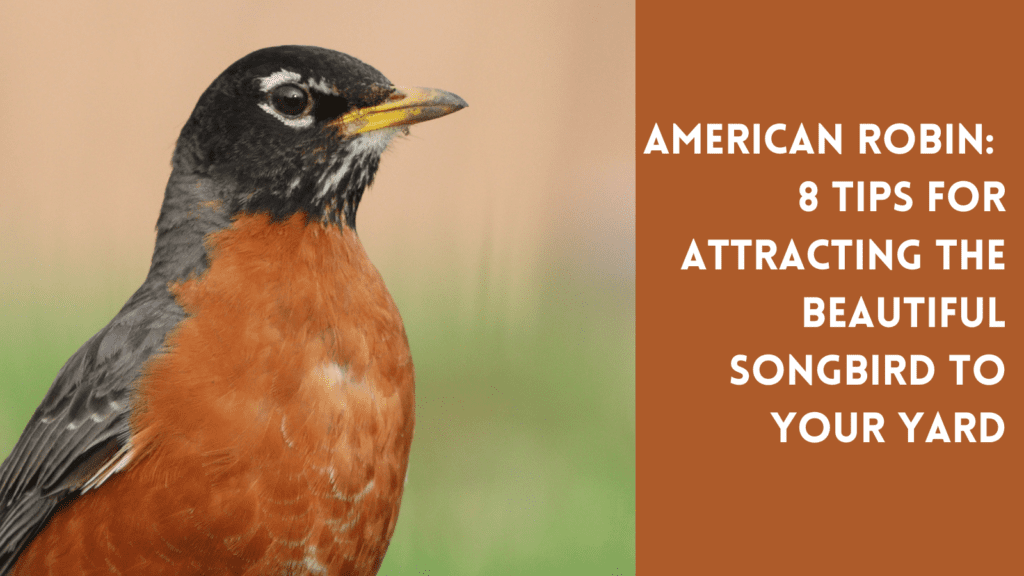
6 – Finches
Finches are tiny songbirds with notched tails, elongated bodies, moderately pointed wings, and round heads with triangular bills.
They are famous for their aerial antics and easy social life (interacting with one another). Finches also produce sweet, not-so-loud sounds, making them a perfect buddy to have around your backyard.
Finches will ideally thrive on a pelleted base diet designed for them—supplemented with fresh greens, other vegetables, egg food, grubs, and some seed.
7 – Starlings
Named after their star-shaped posture while in flight, these attractive small birds exhibit iridescent black-green plumage with a bright yellow bill.
Although a bit of a nuisance to some farmers (due to their scavenging at feedlots and crop-picking behavior), backyard birdwatchers find them relaxing to watch, hence offer them feeders and welcoming roosting space.
Starlings, particularly, like roosting when raising young ones or in the winter.
8 – Baltimore Orioles
To enjoy these brilliant orange, black, and yellow birds all through spring and summer, offer them the right foods with suitable feeders for their relatively large size.
Some of the most popular oriole foods include flowers and flower pieces (like buds); insects, wasps, and mealworms; fruits (mainly apples, oranges, berries, peaches, and bananas); nectar (home-made sugar water or commercial mixes); frozen, fresh, or dried peas; and suet mixed with some berries, fruits, or peanut butter.
Consider installing ant moats with each feeder to help protect the feeders from ants. Avoid oil-smearing on the poles or feeders, which may coat the birds’ feathers, making preening and flight more difficult.
9 – Warblers
Though among the popular songbirds, warblers are pretty difficult to attract to a yard considering that they don’t typically feed on seeds, so they won’t be frequent feeders, as is the case with most birds.
Most species also won’t use your installed birdhouses, making it even harder to lure them into a garden.
However, offering warblers treats such as jelly, suet, peanut butter, oranges, and setting up larger nectar feeders featuring convenient perches will help draw them.
In addition to supplying the birds’ survival needs (water, food, shelter, and nesting sites—where possible), exercise patience.
Warblers are shy that even the activities of other birds can easily keep the wary ones away.
If you’re specifically interested in warblers, you want to keep their friendly landscaping separate from the more active bird feeding stations.
10 – Meadowlarks
Despite having the name larks, meadowlarks (sometimes referred to as western meadowlarks, even though there are Eastern meadowlarks) belong to the blackbird family (Icteridae) and not the warbler or the lark family.
You’ll quickly identify them by their outstanding, attractive color and bold markings on their plumage and the distinctive warbling melody they produce while (mostly) perching on a fence, some wire, post, or a plant stalk.
Meadowlarks are pretty rare in backyards; however, you’ll quickly see them in yards found in rural or agricultural areas.
Attract them by offering ample perching areas, grass seeds, and open locations. Ground bird baths are also an excellent luring tool for these birds.
11 – Cardinals (one of the most coveted songbirds!)
Their beautiful songs and vibrant, crimson plumage are among the many reasons why most birders love to have cardinals in their yards.
Attracting them is straightforward.
Simply offer water, their favorite meal (sunflower and safflower seeds) using cardinal-friendly feeders, and cover.
Hoppers or platform/tray feeders are ideal, considering their large size, which allows the birds to land and feed while facing forward.
As you may already know, cardinals don’t like twisting their bodies to eat—meaning they rarely utilize the perches on traditional tube feeders because they would be compelled to twist their bodies to access the feeding ports.
However, you can always customize your tube feeders (to suit the birds’ feeding preferences) by attaching a tray at the bottom—to serve as the landing and feeding area so they don’t use the feeding ports.
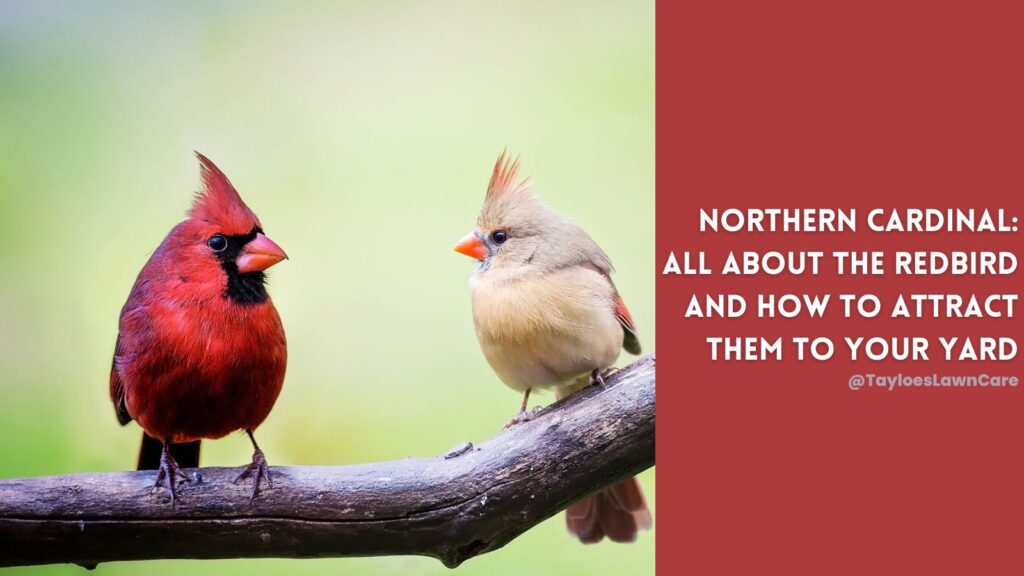
12 – White-breasted Nuthatch
White-breasted nuthatches are mainly insectivorous—enjoying scale insects, ants, spiders, click beetles, stinkbugs, caterpillars, treehoppers, weevil larvae, gall fly larvae, and wood-boring beetle larvae.
However, they’ll still be drawn to your yard if you offer them some large nuts like peanuts and sunflower and, of course, some suet.
Attract a breeding pair by putting up some nest box. Be sure to position the box up well before the breeding season. Also, remember to attach a guard to deter predators from raiding eggs or the young ones.
13 – American Goldfinch
These wild canaries are pretty well-known for their finicky behavior. They may visit your yard one day; the next day…they’re gone.
To attract and keep them around your backyard, ensure you consistently meet their survival needs (appropriate nesting sites, nutritious food, secure shelter, and fresh, clean water sources).
14 – Eastern Phoebe
You’ll mostly find this notorious flycatcher in open woodlands, especially near a water source.
They build their nests using mud, moss, and grass and attach them under rock ledges. You’ll even spot these nests under bridges, on a porch, or underneath the eaves of houses.
When the Eastern phoebes fly-catch their prey, they often fly from perch to perch. And so, it would be a great idea to install a perch in a spot with high insect activity to attract them.
Even though they nest under human-made structures, the birds will gladly accept your offer of a nesting shelf.
Additional General Tips on How to Attract Songbirds to Your Backyard
As they fly up in the air, birds look around for fabulous gardens to visit. They actively seek gardens that will supply their basic needs like food, water, and shelter. Which, of course, the plants in your garden can offer.
However, you need some proper planning to maximize the birds’ visit to your garden and perhaps have them make your backyard their “permanent” residence.
“Your head is a living forest full of songbirds.” ~ e. e. cummings
1 – Plant a garden to feed the songbirds.
When designing your garden, visualize the type of plants you would like to grow both vertically and horizontally.
A diverse landscape—with various plants—will supply the much-needed food and shelter for the birds. Variety helps you, ensure they stay around all year round.
As you may already know, some birds nest up higher than others, some in the middle, and others very close to the ground. That gives you even more reason you should consider the various layers of plants.
Below are some great plant ideas to start you off:
Note: Be sure to ascertain whether or not they will survive your location’s climate and soil type.
Crabapple tree:
They’re desirable for their colorful foliage and attractive blooms and fruits that attract birds.
They’re easy to care for and can withstand drought. Their not-too-big size (especially the dwarf type) makes them a good fit for any garden size, as they offer bird food and shelter—from summer through winter.
Consider planting a cultivar with small fruits (fruits with a diameter less than ¾ of an inch) to allow for easy grasping and consumption by the birds.
Also, cultivars with fruits that persist into fall will ensure these visitors stay around even longer than the crabapple species, which feature fruits that drop quickly from the tree.
Chokecherry (Prunus virginiana)
This plant is ideal for medium-level cover and offers food enjoyed by over 70 species of birds.
The shrub’s fruits don’t drop to the ground (despite them ripening from July through October); instead, they dry on the branch, offering high-energy food to the many birds, which also depend on the plant for shelter.
The shrub also hosts tent caterpillars—which the songbirds feed on in spring and the summer.
Vines:
Flowering vines like coral honeysuckle, Virginia creeper, and trumpet vine are the perfect cover and nesting options, especially in smaller spaces.
They’re great attractors of hummingbirds.
Juniper:
These plants offer quality nesting space for the birds while keeping them fed with good food in the winter and fall.
Elderberry:
The deciduous elderberry shrub is a fast grower and produces fruits in the summer. Its umbrella-shaped white flower clusters attract insects, bringing more birds to your garden.
2 – Install multiple songbird feeders
Depending on the size of your garden, you may have to put more than two feeders in place to cater to the birds’ feeding preferences adequately.
The various bird species prefer different feeding styles over others so that the varieties will accord them the benefit of choice.
For instance, blue jays, junco, and cardinals prefer ground-feeding (though a sturdy hopper still serves them well), while the nuthatches and finches enjoy gravitating around hanging cylindrical feeders.
In severe weather, consider feeding the birds twice daily; however, make sure what you provide is proportionate to the demand. Otherwise, you might attract rodents.
You also want to stick to your established feeding routine because the local songbirds will grow accustomed to it and rely on you.
Strategically position the feeders.
Different birds exhibit different behaviors when visiting feeders. While some will swoop in and directly head for the feeder, others will quickly be put off by a highly exposed feeder.
Consider positioning the feeder near some cover so the birds can feel safe as they feed. This will cater to the shy species like the cardinals as well.
Low-lying tree branches and fences are popular cat hide-outs. So be sure to locate your feeders away from such areas.
The post supporting the feeder should be smooth and straight to make it difficult for squirrels and cats to climb. A sloped baffle will make it even more difficult for the squirrels to balance.
- Mount the feeding tray to a significant height—off the ground –so the birds don’t become easy targets for cats and other backyard predators.
- You can scatter some food on your lawn to attract the ground-feeders like blackbirds, chaffinches, sparrows, and thrushes.
- Keep the inside and outside of the feeders clean to make them appealing to the birds and reduce the chances of diseases and parasites spreading where the birds congregate.
Through regular cleanings and inspections, you also get to catch and discard moldy or unused seeds, which is unhealthy for the birds.
A drop in feeder attendance indicates that the seeds may be moldy or wet, hence unattractive to the birds.
Note: Use diluted white vinegar, warm water, or a mild dish soap mixture to clean the feeders thoroughly, then leave to dry.
Wondering which foods attract your favorite songbird species?
Well, the truth is that different bird species exhibit different feeding preferences and dietary needs. Therefore, the first step is to understand what species surround your location and the type of food they enjoy.
Naturally, most songbirds feed on plant materials (like flowers, grass, and seeds). Many enjoy insects (including worms, mosquitoes, crickets, and grasshoppers), nuts, and small fruits.
Supplements for your feathered friends:
However, depending on the birds you want to attract, you may have to consider supplemental foods such as:
- Mealworms. These are a great source of protein. They aid in the food hunt process in the spring, especially for the parent birds looking to feed a nest of hungry chicks. These live larvae are favorites of song thrushes, bluetits, robins, and blackbirds.
- Sunflower hearts. Garden finches, siskins, robins, and house sparrows enjoy this protein-rich meal packed with unsaturated fats. No need to remove the husks.
- Peanuts. Great spotted woodpeckers, chaffinches, and nuthatches love this legume. However, be sure to use a feeder mesh. Additionally, the seeds should be high-quality—to avoid choking cases in the small birds, especially in the spring.
- Suet. This treat is high in calories, providing much-needed energy to the birds in the colder months. Great spotted woodpeckers, blue tit, and long-tailed tits cannot resist this food source.
- Seed mix. Mixing the different types of birdseed is economical and convenient, especially for winter feeding. Large proportions of millet and sunflower seeds (or the different nut varieties, depending on the species you would like to attract) are a great combo instead of unappetizing fillers like corn, wheat, or milo.
Hint: To naturally boost the nutritional value of your feeders, consider raking leaves under shrubs—to serve as mulch for healthier growth.
Pillbugs, earthworms, spiders, and insects will then thrive in the decomposing compost or mulch. These will provide food to many ground-feeding songbirds such as towhees, sparrows, and thrashers.
3 – Provide a water source
Hot days drive birds to drink and bathe more. Offering them a water source near protective shrubs, especially during the summer, is one of the best ways to maximize their visits to your yard.
Just ensure the baths are 1-2 inches deep, sloped, and rough enough for the birds to grip better.
Incorporating some dripping effect will lure even more songbirds. Install a dripper, mister, or circulating pump to do that.
If you can, go for a more extensive alternative, like a pond or a waterfall. You’ll attract even more wildlife to this feature.
Be sure to install several bath points to avoid overcrowding when the birds visit. If resources allow, go the extra mile to install different water environments, such as moving, static, or misting, to attract the different species.
Consider mounting the baths on pedestals if you have cats prowling your neighborhood.
Cleansing the birdbath is a must for songbirds… here is how:
Also, clean the baths two or more times a week using a stiff scrubbing brush—to keep them attractive and as healthful as possible.
Alternatively, to minimize the cleaning frequency, consider the following tips:
- Position the bath away from the feeder(s) to ensure the spilled hulls and seeds don’t drop in the water.
- Mount the baths to keep them out of reach by the pets or children.
- Place the bath in a semi-shady spot to minimize evaporation and algae growth. Adding copper elements or wildlife-approved enzymes is also a great way to thwart algae growth.
However, ensure the location is free from falling leaves or grass clippings, which may easily lead to clogging.
Finally, always pour out the old water (when refilling the bath) instead of just topping up.
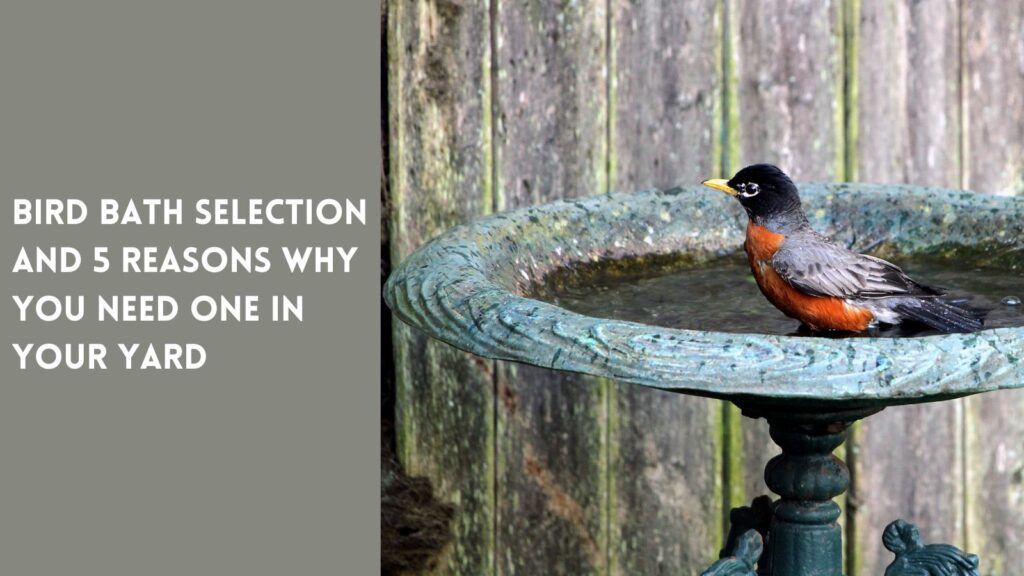
4 – Offer shelter to your songbirds
Want these feathered friends to make your yard their home? Then, install a birdhouse to guarantee their safety.
Not all birds will accept a ready-made house, and even those that accept often have different preferences and needs depending on the species. And so, ensure your type and size of birdhouse matches the needs of your preferred type of birds.
For instance, wrens, chickadees, and most other small birds will gladly reside in a house 8 inches tall and four by five inches at the base.
For large birds like owls, consider larger houses measuring 24 inches high and 10 by 10 inches at the base. Also, ensure the entrance hole matches the house and birds’ size.
Lastly, ensure the installation location is safe and adequately elevated off the ground for maximum bird security.
5 – Encourage the songbirds to nest in your yard
The truth is that not all birds will trust the birdhouses in your yard.
And so, how do you encourage nesting? Consider growing native trees, flowers, and shrubs. They are the best natural nesting sites for birds.
Rarely do such plants require maintenance if you offer the right growing conditions—preferably, their native climate.
You can also offer birdhouse construction materials like pet fur, string, yarn, and hair to facilitate the other species that prefer to build the nests. Put the materials in a suet cage feeder for easy access.
Some birds will just be drawn to the natural offerings, like grass clippings on your lawn, brush piles, and the weed fluff from the dead flowers around your yard.
6 – Install a perching stick where the songbirds can rest
Birds need a place to rub their beaks after feeding or at least rest as they preen their feathers. Indeed, there is no better place than natural trees and bushes.
However, consider perching sticks if you don’t have trees around your yard.
Perching sticks are especially a big plus if you love photography. You can install them in your preferred location, with adequate lighting and a beautiful background, to capture great images of the birds.
They are pretty easy to make from various materials, including ropes made of hemp, braided ropes, natural wood, and many others.
For a more natural setup, you may want to use old branches.
Place the perches only a few feet away from the feeders to prevent the birds from being unnecessarily exposed to predators.
Related Reading:
You Will Enjoy Watching These 14 Songbirds In Your Yard
While some songbirds will quickly and frequently visit your yard, others may take weeks or a few months. That fact is true, even with very bird-friendly landscaping.
In such a case, exercise patience. And once the songbirds notice the refuge you provide them, ensure you consistently supply their survival needs. Otherwise, they may never visit again or nest within the perimeters of your yard.
Author Profile

- Deborah Tayloe is the CEO and co-founder of Tayloe's Lawn Care Services, LLC. She has a B.S.Ed and holds certificates in soil and water management and herbology from accredited programs.
Latest entries
 GardeningSeptember 27, 2025What perennials, shrubs, and trees don’t like fall pruning (and why)?
GardeningSeptember 27, 2025What perennials, shrubs, and trees don’t like fall pruning (and why)? Trees and ShrubsSeptember 14, 2025Fall Shrub Pruning Guide (September–October)
Trees and ShrubsSeptember 14, 2025Fall Shrub Pruning Guide (September–October) Trees and ShrubsApril 22, 2025Boxwood Blight: Early identification and isolation
Trees and ShrubsApril 22, 2025Boxwood Blight: Early identification and isolation Flower GardenApril 8, 2025John F. Kennedy Rose: Hybrid tea rose with elegant white blooms
Flower GardenApril 8, 2025John F. Kennedy Rose: Hybrid tea rose with elegant white blooms

